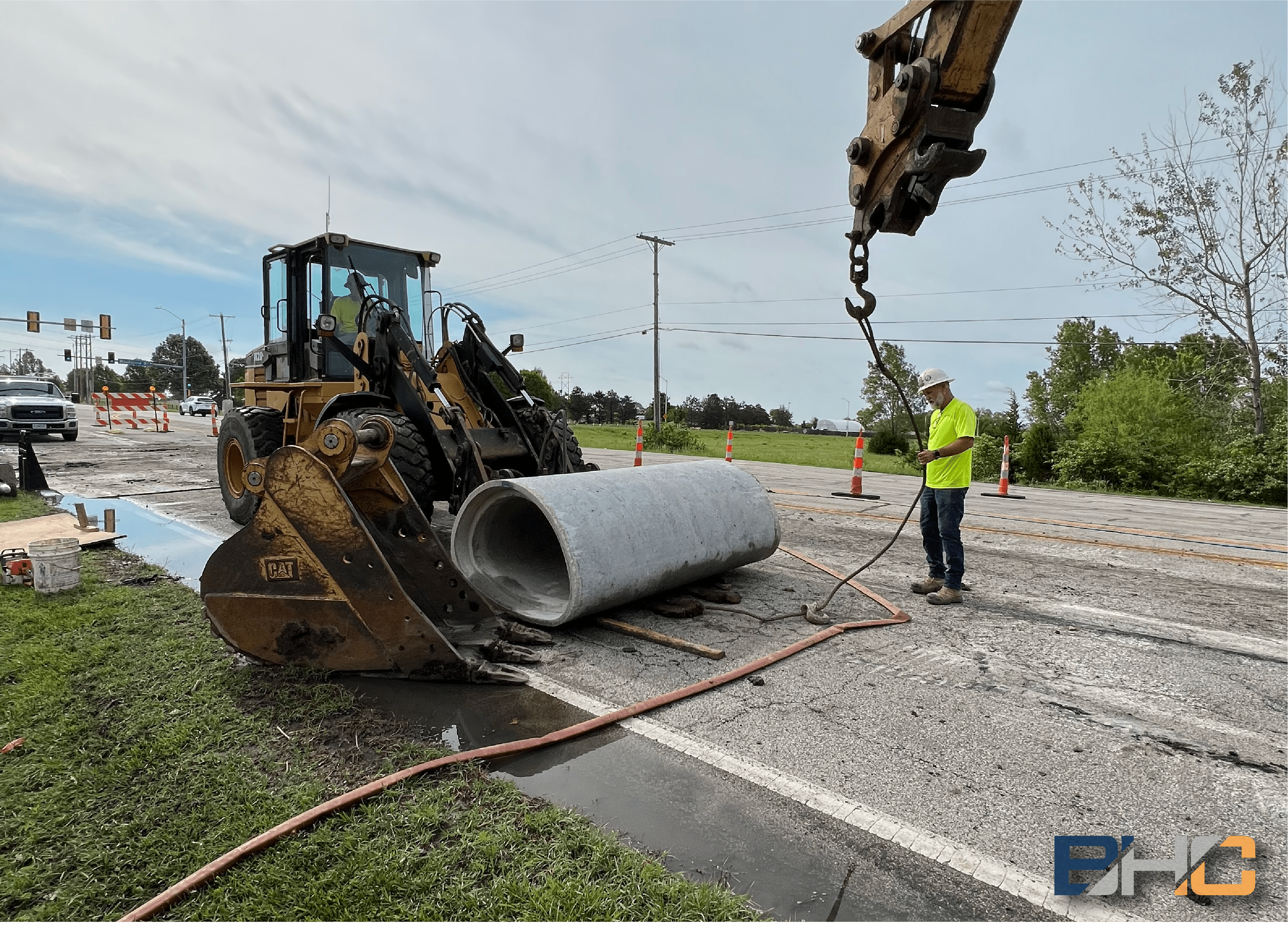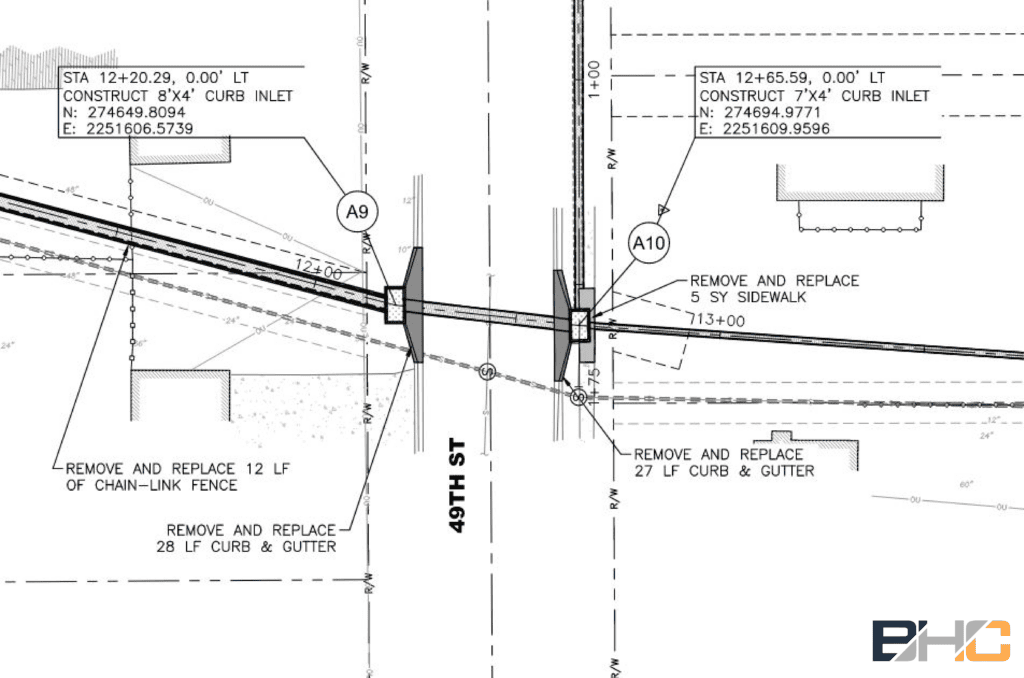Three Things to Consider When it Comes to Stormwater Design

Hiring the right civil engineer to design stormwater systems is an important decision when completing any kind of project requiring stormwater installation, reconfiguration, or reparation. Our ‘No Problem’ customer service experts in our public works group overcome the challenges of stormwater design on a regular basis. Understanding the elements that go into stormwater design can actively contribute to the innovative development of stormwater infrastructure minimizing flooding risks, preserving water quality, and creating a sustainable environment.
It is up to the civil engineer to look at what the pipe network is doing and evaluate what the best options are moving forward. Some questions that must be answered are, how much water is making its way to the curb inlets and adjacent properties? Additionally, do the pipes need to be lined to extend the life of the current system, or do the pipes simply need to be replaced altogether?
We will explore the fundamental aspects that shape storm sewer design, ranging from the control of quantity to understanding the placement of a stormwater system.
- Understanding Inlet Spread and Inlet Capacity
The essential point here is understanding how steep or flat the road is and observing the spread, which is how far the water goes from the gutter out to the middle of the street depending on the slope. Why does spread matter? Driving down the street on a day with heavy rainfall and the water on the street is several inches deep causes hazardous conditions with adverse effects. The deeper the water, the more dangerous the road. APWA Section 5600 lists the criteria of overflow depth measurements equaling a maximum of seven inches in the roadway cross section.

A past stormwater project that required pipe maintenance and inlet assessment was the Renner Road Storm Drainage Improvements. The pipes and inlets located at this site were in bad condition and required replacement. Our civil engineers also evaluated the inlet spread to determine if additional pipes were needed.
Our public works experts are working on a road project in Spring Hill, Kansas at 199th Street. This area is naturally flat, which makes the spread extend farther. The spacing of the curb inlets is very dependent on the road slope, so our engineers must find the best way to guide stormwater from point A to point B, especially when there is minimal help from the slope of the road design on a project of this nature.
- Outlet Stormwater and Configuring Drainage Patterns
When developing stormwater designs, more essential questions must be asked to determine how to create a successful and efficient network. After capturing the stormwater from the overflow path, where is the water going to go? Is it going to collect on the site or on the road? These questions fall into the category of understanding how the water exits the project site. Taking into consideration the effects of outlet water is important for the overall stability of the area around the site. Civil engineers should make sure the outlet will not flood another property downstream or cause erosion in the creek the water is making its way to.
In most road and storm sewer projects, water will come in the way it was originally intended and goes out the same way. Oftentimes there are low points or creeks where stormwater can funnel and follow the natural path. Civil engineers try to follow the natural path as much as possible to create the least amount of disturbances to the area. With any roadway design or land development project though, there could be alterations to that path as the topography changes to accommodate the development. Land developers must often break the natural drainage patterns because of client needs, making it necessary to change the high and low points of the topography.

Breaking the original drainage patterns and surface material makes the land more impervious and the water flow faster. Finding an outlet for water is the next step in deferring the water away from a site. How long is it going to stay underground and remain in the detention system before being released and what are the effects of this outlet? These are the kinds of questions that will help civil engineers better prepare for their site designs.
Another element to keep in mind when configuring drainage patterns is the importance of draining away from buildings, sidewalks, and intersections. Civil engineers need to look at where the low points are in the road to avoid trapping water into puddles. These not only inconvenience drivers and pedestrians but can also create mosquito ponds in the summer or large ice patches in the winter. This can be detrimental to an area, especially those with high traffic volumes.
- Floodplain Proximity & Regulations
The Federal Emergency Management Agency (FEMA) identifies areas that have an elevated risk of flooding and has additional requirements for civil engineers to complete when designing in these areas. The FEMA Flood Map Service Center provides public flood maps as a resource for flood hazard information. These maps are continually updated and are beneficial to review before planning to understand the associated risks of being within proximity to a creek or body of water prone to flooding events.
A Certified Floodplain Manager (CFM) is a distinction that civil engineers can obtain, helping them better understand what information FEMA is trying to convey as well as their policies. Within our public works team, Senior Project Engineer, Katie Bushong, holds her CFM certification which helps our team deliver better ‘No Problem’ customer service to our clients whose projects require floodplain guidance.
Stormwater design involves the analysis of several factors and implementing innovative strategies to effectively manage stormwater runoff and prevent flooding. Our experts have extensive knowledge of stormwater management and use a variety of tools to accomplish the goals of our client. The myriad of analyses and machines like our pipe camera enable us to get our client the most current data about their storm system. This is incredibly important in the design stage, saving time and making for a more efficient project overall. Effective stormwater management can preserve natural resources, respecting the environment as well as safeguarding the well-being of future generations. Oftentimes, stormwater will outlet into local creeks or rivers, but engineers also design wetlands or rain gardens to make more efficient use of the water. These engineers work behind the scenes to ensure that our communities continue to flourish. As we develop new and innovative ways to manage stormwater, we will undoubtedly uncover more sustainable practices. Interested in experiencing ‘No Problem’ customer service when meeting the stormwater design needs of your project? Connect with one of our public works experts who can help provide quality stormwater plans on your next project.
